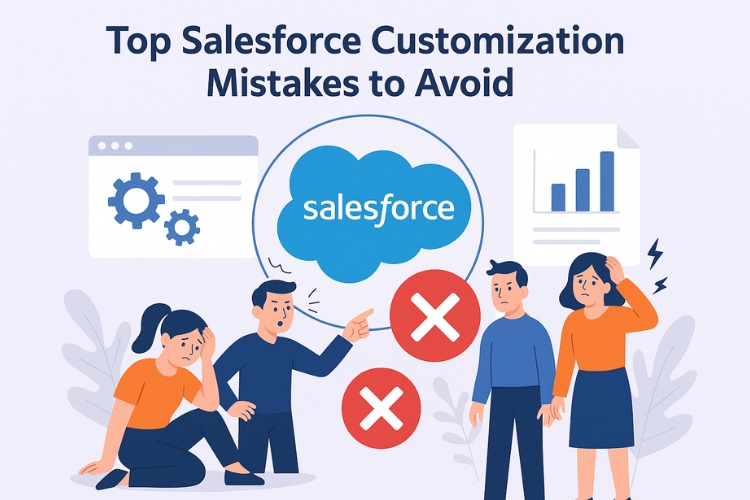Salesforce is one of the most powerful CRM platforms in the world, offering endless customization possibilities. However, with great flexibility comes the risk of making costly mistakes. Whether you’re a business owner, administrator, or developer, understanding the Top Salesforce Customization Mistakes is crucial to ensure your CRM system works efficiently and grows with your business.
In this blog, we’ll explore the most common pitfalls in Salesforce customization and provide simple ways to avoid them.
What is Salesforce Customization?
Salesforce customization involves tailoring the platform to meet your business's specific needs. This could include:
- Creating custom objects and fields
- Automating workflows with process builder or flows
- Integrating third-party apps
- Modifying user interfaces
- Developing Apex code for complex processes
While customization can boost productivity and streamline operations, doing it wrong can lead to performance issues, higher costs, and poor user adoption.
Top Salesforce Customization Mistakes to Avoid
Let’s dive into the biggest mistakes businesses make while customizing Salesforce and how you can steer clear of them.
1. Over-Customizing the Platform
Problem:
One of the most common Salesforce customization mistakes is doing too much. Businesses often go overboard by creating too many custom fields, objects, and code snippets.
Why it’s harmful:
- Makes the platform cluttered
- Increases page load time
- Confuses end-users
- Complicates future upgrades
Solution:
Stick to what’s essential. Start small and only add custom elements when absolutely necessary. Use standard Salesforce features as much as possible.
2. Ignoring User Needs and Feedback
Problem:
Customizations are often done from a developer or management perspective, ignoring the needs of actual users.
Why it’s harmful:
- Leads to low adoption rates
- Results in unnecessary features
- Causes frustration among users
Solution:
Involve users in the planning phase. Conduct surveys, gather feedback, and test customizations with a small group before full implementation.
3. Not Documenting Customizations
Problem:
Businesses often fail to document what changes were made, why, and by whom.
Why it’s harmful:
- Makes troubleshooting difficult
- Slows down onboarding of new admins
- Leads to duplicate work
Solution:
Maintain a detailed log of all customizations. Include screenshots, logic, field usage, and who requested the change.
4. Poor Data Structure and Field Management
Problem:
Creating too many unnecessary custom fields or choosing incorrect data types.
Why it’s harmful:
- Slows down reporting
- Wastes storage space
- Causes confusion in data entry
Solution:
Plan your data model before creating fields. Reuse existing fields where possible. Use picklists instead of free text to maintain consistency.
5. Ignoring Salesforce Limits
Problem:
Every Salesforce org has limits, API calls, data storage, governor limits for Apex, etc. Many users are unaware of these.
Why it’s harmful:
- Customizations may fail unexpectedly
- System may slow down or crash
- Increased costs for exceeding limits
Solution:
Understand your org's limits. Use tools like the "System Overview" page to monitor usage regularly.
6. Not Testing Customizations Properly
Problem:
Implementing customizations directly in production without testing.
Why it’s harmful:
- Increases risk of breaking existing features
- Affects live data and users
- Makes troubleshooting harder
Solution:
Always test in a sandbox environment. Use unit tests and get feedback from stakeholders before deploying to production.
7. Lack of Integration Planning
Problem:
Adding third-party integrations without considering their long-term impact.
Why it’s harmful:
- Can slow down the system
- May result in data conflicts
- Leads to higher maintenance costs
Solution:
Plan every integration carefully. Choose only trusted tools that align with your business needs and Salesforce roadmap.
8. Avoiding Declarative Tools
Problem:
Jumping straight to Apex code when a simple Flow or Validation Rule can do the job.
Why it’s harmful:
- Adds unnecessary complexity
- Harder to maintain
- Slows down performance
Solution:
Use clicks before code. Salesforce provides powerful declarative tools like Flow, Process Builder, and Approval Processes that can handle most use cases without writing code.
9. Failing to Plan for Scalability
Problem:
Creating customizations without considering future business growth.
Why it’s harmful:
- Results in constant rework
- Customizations break with new updates
- Hampers automation
Solution:
Always think long-term. Ask yourself: Will this feature still work when we double our team or expand into new markets?
10. Not Training Users on Customizations
Problem:
Rolling out new features without informing or training users.
Why it’s harmful:
- Users may not know how to use new features
- Increases support tickets
- Lowers return on investment
Solution:
Train your users with videos, walkthroughs, or live sessions. Highlight the benefits and gather feedback for improvements.
Best Practices to Avoid Salesforce Customization Mistakes
- Involve all stakeholders before starting any customization
- Create a change management and deployment plan
- Test everything in sandbox
- Clean up unused fields and features regularly
- Monitor performance and adoption
- Stay updated with Salesforce release notes
- Use a certified Salesforce consulting company for large-scale changes
Conclusion
Salesforce customization is a powerful way to tailor the CRM platform to your business needs. However, without proper planning, it can lead to major headaches. By avoiding the Top Salesforce Customization Mistakes, you can ensure your system remains scalable, user-friendly, and efficient.
Always follow best practices, involve users, test thoroughly, and don’t hesitate to seek expert guidance when needed. A smart approach to customization can significantly boost your ROI and improve overall user satisfaction.
If you're unsure where to start, working with Salesforce certified consultants can make a big difference in achieving your goals faster and more efficiently. At CloudMetic, we help businesses customize Salesforce the right way without the risks and with long-term success in mind.
FAQs
1. What are the top Salesforce customization mistakes to avoid?
The most common mistakes include over-customizing, ignoring user feedback, skipping documentation, improper field management, and lack of testing or training.
2. How can over-customization in Salesforce hurt my business?
Over-customization can make the system slow, confusing, and expensive to maintain. It can also reduce user adoption due to complexity.
3. Why is it important to test Salesforce customizations in a sandbox?
Testing in a sandbox allows you to spot bugs and ensure stability before rolling out changes to your live environment.
4. Should I use Apex code for all Salesforce customizations?
No. Use declarative tools like Flow or Validation Rules first. Apex should be a last resort for complex logic.
5. Can a Salesforce consulting company help prevent customization mistakes?
Yes. A certified Salesforce consulting partner can guide you with best practices, scalable solutions, and long-term planning.





Comments